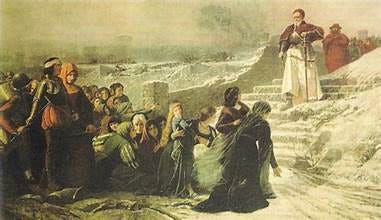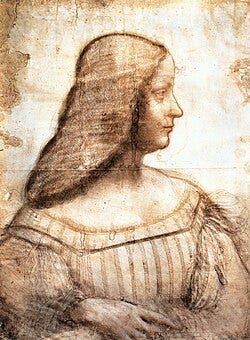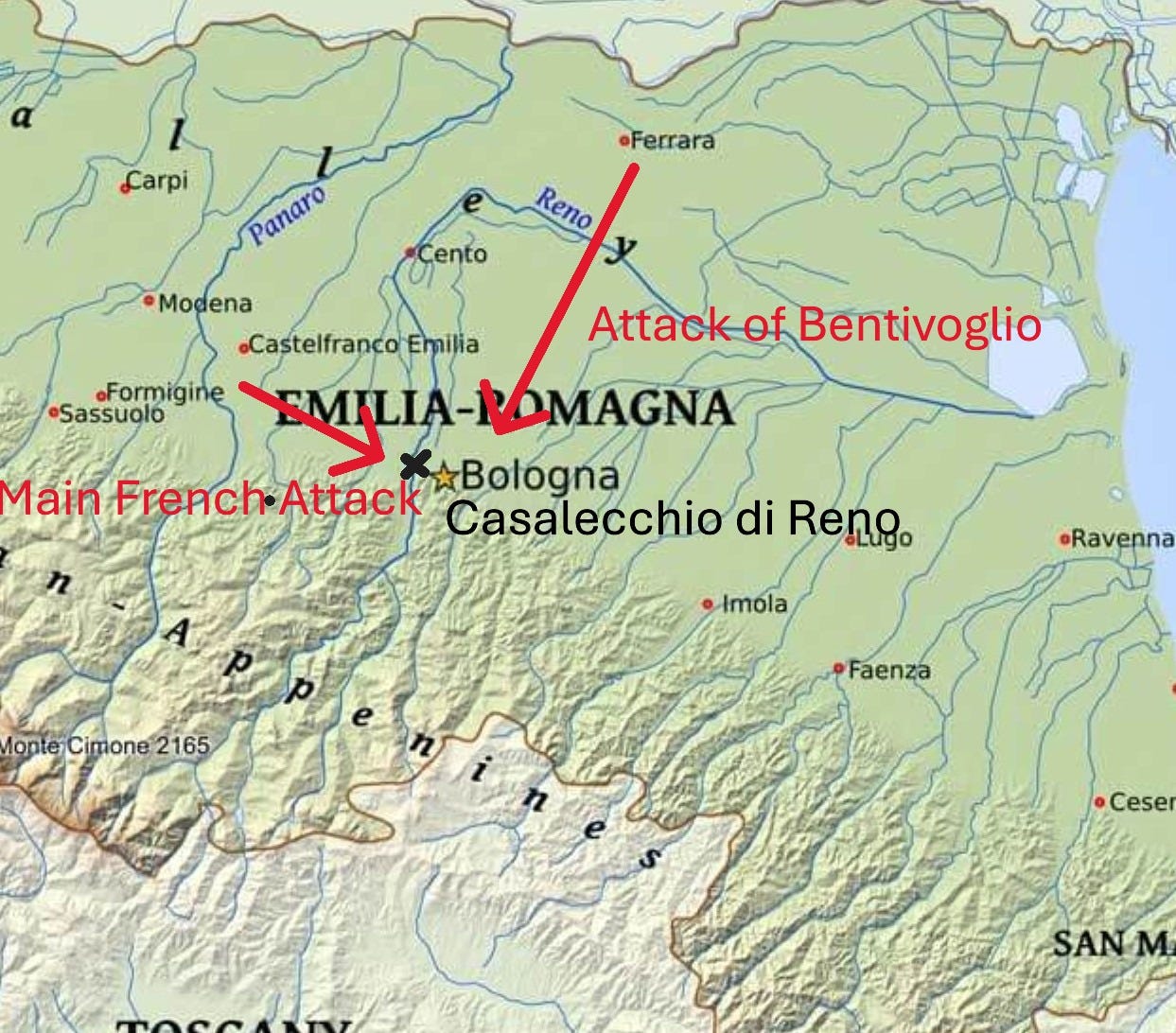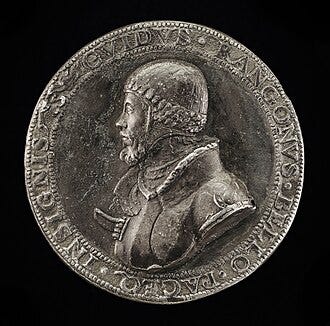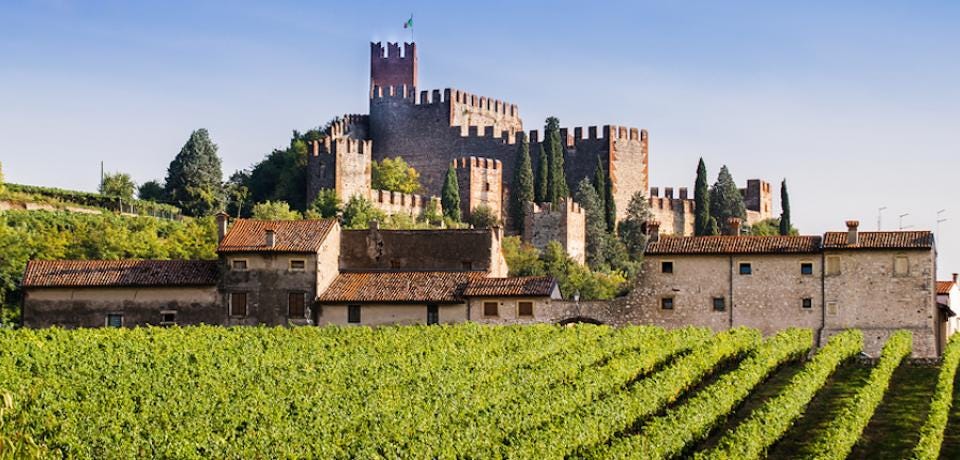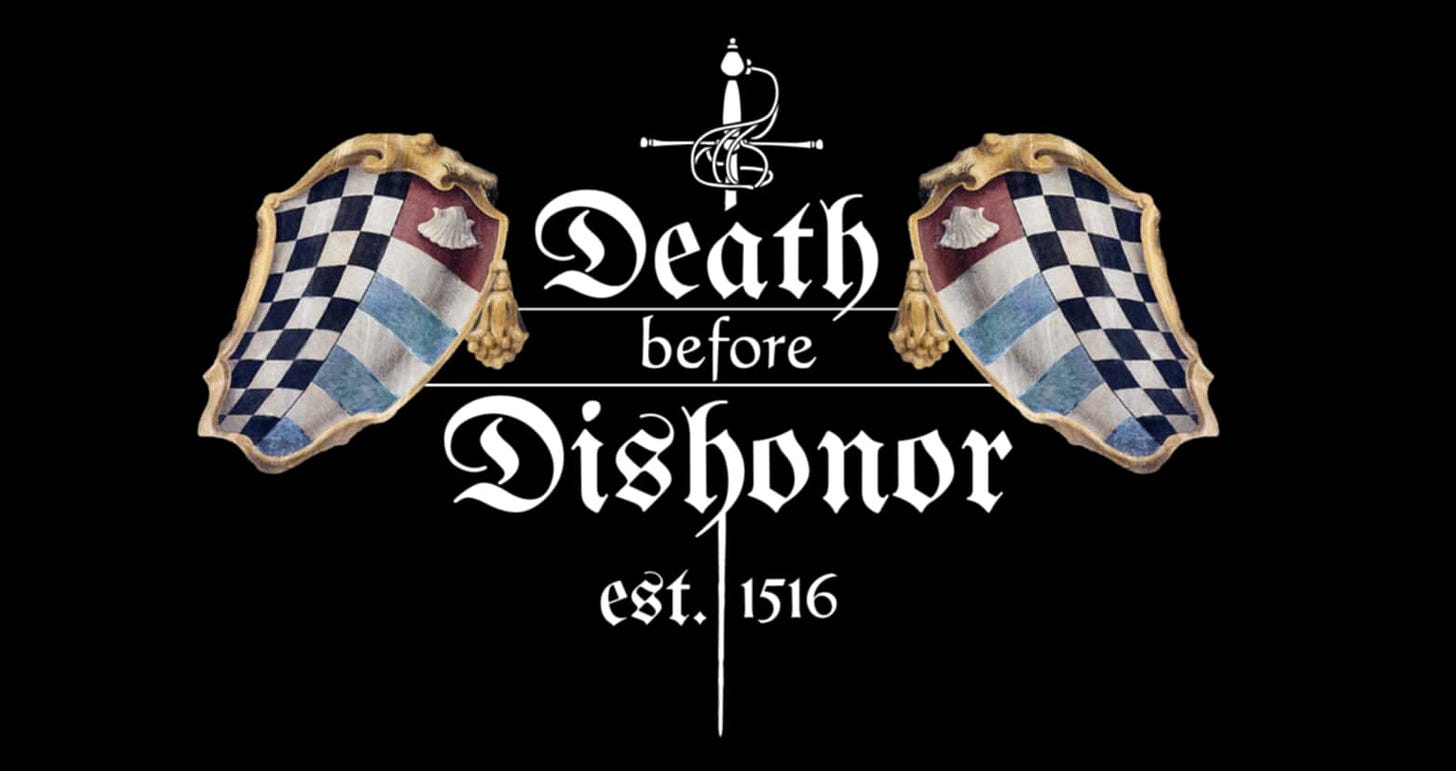For three long years, Hugo Pepoli had rotted in a Roman prison. But at the close of 1510, he finally stepped out into the cold, sharp air of December as a free man. The Pope, having decided that Hugo and the Pepoli family no longer posed a threat—and might even be useful—ordered the release of the Bolognese prisoners from the dank cells of Castel Sant’Angelo.[1]
Hugo returned to Bologna just in time to ring in the new year. And 1511 was shaping up to be a year unlike any other—for both Hugo Pepoli and the city he called home.
Pope Julius II had set his sights on Ferrara, and Bologna was to become the staging ground for his grand campaign. In January, the Pope personally led an army to besiege the fortress of Mirandola. He took the town with surprising speed, leaving the Duke of Ferrara cut off from French reinforcements. North of the embattled duchy, near Verona, the French tried to punch through to help their allies.
But they ran into Guido Rangoni and the Venetians. Stationed in the area and fighting for the Republic of Venice, Rangoni’s forces held firm, blocking any French breakthrough. Ferrara was now surrounded—boxed in by enemies and abandoned by its supposed protectors.
To the south, the mighty fortress of Zaniolo stood as the last true barrier between Ferrara and total collapse. It was the only thing stopping the Pope and his Venetian and Spanish allies from launching a final assault on the city itself. And now, all three powers were massing their forces for the strike.
Inside Ferrara, things were no better.
A small garrison of French knights and infantry had taken up residence within the city walls. Though allies on paper, the French behaved more like occupiers—arrogant, entitled, and especially notorious for their treatment of local women. The people of Ferrara endured their humiliation in silence—until one night, a line was crossed.
A Ferrarese woman was raped by French soldiers.
The city exploded in fury.
The people rioted. Armed citizens clashed with the French in the streets. By the end of the chaos, fourteen Frenchmen lay dead, and fifty more were sprawled across the cobblestones, wounded and bleeding.[2]
Ferrara was unraveling. With enemies at the gates, allies turned predators within, and its defenses crumbling fast, the city seemed poised on the edge of total disaster.
A Meddlesome Woman
Into this storm of chaos and bloodshed stepped one of the most formidable women of the Renaissance—Isabella d’Este, the Lady of Mantua.
Ferrara’s ruling Duke was her brother, and Isabella watched with mounting dread as the d’Este family teetered on the edge of ruin. The city was under siege from without, in turmoil within, and worse still, the French—their only real hope—were trapped on the far side of enemy lines.
But Isabella’s position was far from simple. Officially, Mantua was allied with the Pope. Unofficially, both she and her husband, the syphilitic and indecisive Marquis of Mantua, knew that their true interests lay with a French victory. For if Ferrara fell to the Pope, then Mantua would almost certainly be next.
Complicating matters further was a painful personal entanglement. In a previous episode of this conflict—The Lion Roars—the Marquis had been captured by Lucius Malvezzi and held by Venice. To secure his release, Isabella had made a harrowing bargain: her own son was sent as a hostage to Pope Julius II.
Now, with her husband too feeble to act and her son in the clutches of the Pope, the burden of decision-making fell squarely on Isabella’s shoulders. It was the kind of impossible choice noblewomen had faced throughout history: save a child, or save a realm?
Isabella chose as many others before her had—a domain takes generations to build; a child can be made in a night.
Through secret channels—likely through her sister, who was married to Hannibal Bentivoglio—Isabella quietly encouraged the French to demand passage through Mantuan territory. Her lands bordered Ferrara; if the French could slip through, they could finally reinforce the beleaguered city.
There was just one problem: Mantua was laced with strong, well-defended fortresses. A military campaign through the region would be long and costly. The only real solution? Let the French pass unopposed.
Following Isabella’s covert advice, the French commander of the western army—then facing Mirandola—formally presented a letter to the court of Mantua in late January 1511. In it, he declared his intention to pass through their lands with troops bound for Ferrara’s defense.
If they resisted, he warned, he would bring “fire and death” to Mantua.
Cornered and without hope of Papal reinforcements—reinforcements everyone knew the Pope would not send—the Marquis of Mantua caved. He “reluctantly” agreed to the French demand, begging only that they do as little damage as possible as they moved through his domain.
And so it happened: the Bentivoglio, the French, and their Ferrarese allies passed peacefully through Mantuan lands. Within days, they launched a surprise assault against the enemy forces surrounding the crucial fortress of Zaniolo.
The trap had been sprung—and it bore Isabella d’Este’s elegant, ruthless fingerprints.[3]
Coming out of the fog and mist, the force of Bentivoglio, French and Ferrarese warriors surprised the enemy army near the fortress of Zaniolo. They killed thousands and took many thousands more prisoner.
For Pope Julius this was a terrible turn of events. Ferrara had seemed within his grasp. But that was no longer. Ferrara was out of his reach. And now the Bentivoglio and their allies were poised to attack Bologna itself.
Showdown in Bologna
The enemies of Pope Julius II were closing in on Bologna. From the west the main French army outflanked the Papal army and marched through the territory of Modena until they were in striking distance of the city itself. In the northern end of Bolognese territory, the exiled Bentivoglio family stirred rebellion in the Bolognese countryside, and signed up men in the villages to serve in the Bentivoglio army.
Cardinal Alidosi, the Pope’s hated minister, was in charge of defending Bologna and holding it for the Pope. But he had only a thousand infantry, mostly exiles from Genona, to defend over eight kilometers of city walls—far too little to hold against a serious threat.
Desperate, Alidosi secured papal permission to raise local militias. He reached out to nobles like Hugo Pepoli to form companies of Bolognese defenders. But he chose poorly. Many of the nobles he chose to lead the Bolognese were he had imprisoned and tortured in the Castel Sant’Angelo, men like Hugo Pepoli.
Despite Hugo’s confinment he seems to have been one of the few commanders who were loyal to the Pope. In the garrison of the city he served under the command of a Genoese nobleman, Octavian Fregoso. This was a man who would later play a big role in Hugo’s life.[4]
Genoa was then under the domination of the French and Octavian and his family were opposed to the French. Octavian knew of many potential rebels in the city of Genona and he was deeply concerned that if the French captured him, he would be tortured and forced to reveal what he know.[5]
Hugo Pepoli, still working with Octavian Fregoso, saw what was coming. As a native of Bologna, he could read the mood of the people, and it was turning deadly. Fregoso had even more reason to worry—should the French take him alive, Genoese politics meant torture and betrayal of his allies were almost guaranteed. So he struck a deal with Hugo: if rebellion broke out, Hugo would take charge and ensure Fregoso and his Genoese mercenaries could escape unharmed.
Every day, that deal looked more and more like an escape plan.
The people of Bologna seethed with discontent. For years they had borne the arrogance of the Papal officials and their soldiers. They had stolen from and even killed Bolognese citizens. When the Bolognese had the audacity to complain to one papal official about the abuses of foreign soldiers in the city, one Papal official responded, “You are the foreigners. This place is ours.”[6]
The French army were soon at Casalecchio di Reno, a key location to the defense of Bologna, since it controlled the water supply of the city. They were only five miles (8 km) away.
Sensing the rising tension, the Pope quietly slipped away to Ravenna, leaving Bologna to its fate. His departure emboldened the citizens. After months of looting and extortion by Papal troops, the Bolognese were done. When the Duke of Urbino tried to send reinforcements into the city, the citizens blocked the gates and raised arms, even against soldiers of the Pope himself.[7]
Alidosi now found himself in a nightmare: trapped in a hostile city, the gates guarded by men loyal to the Bentivoglio, who would have gladly strung him up from a lamp post.
In a last-ditch effort to reassert control, he ordered the Bolognese companies to leave the city and join the Papal army outside the walls. But most refused: “the supporters of the Bentivoglio family, who were the majority, found various excuses and declined to leave.”
Then Alidosi made the fatal move. To reinforce the garrison, he called for 1,000 Spanish infantry under the command of Ramazzotto the Priest. It was a catastrophic miscalculation. Only months earlier, Ramazzotto’s men had looted every village on a fifteen-mile long stretch of road outside of Bologna. The people of Bologna remembered—and feared—them.
As Ramazzotto approached, the city exploded. With cries of “People! People!” the Bolognese barred the gates and refused to let the Spanish in.
Alidosi panicked. He slipped out of Bologna under cover of night.
Seeing the city falling, Hugo Pepoli honored his agreement. He helped Octavian Fregoso and his mercenaries escape. But Hugo stayed behind. He retreated to the citadel—the fortress the Pope and Alidosi had built against the people’s will. It was now a refuge for anyone who had served the Pope and feared reprisal.
Word reached the Duke of Urbino’s camp that Bologna had risen. Alidosi had fled. The Papal army broke. Soldiers deserted in droves, abandoning cannons, baggage, and formation.
Inside the city, the Bentivoglio faction struck. They stormed the main western gate, battered it open “despite resistance,” and sent men up the Asinelli Tower, where a burning torch was raised as a signal.
At once, the French sprang into action. Some crossed the Reno River by bridge, others waded through its freezing waters. Avoiding the shattered enemy camp, they raced straight to the city and entered alongside the Bentivoglio.[8]
Bologna descended into chaos.
Peasants surged in from the countryside to plunder and kill the retreating Papal soldiers. Inside the walls, old vendettas resurfaced with lethal force. But Hannibal Bentivoglio moved quickly. He ordered the gates sealed to stop the violence and prevent citizens from hunting down the fleeing troops. He promised the French commander a heavy indemnity in exchange for discipline—and looting was halted.
Inside the citadel, Hugo Pepoli waited.[9]
The fortress had little food, fewer soldiers, and almost no ammunition. Like many of the Pope’s strongholds, it had been built more to intimidate than to survive a siege. Now, it was all that stood between its defenders and the fury of a liberated city.
Help would not come.
The Venetian-Papal army had been broken and scattered. It would take months—and reinforcements from Spain—before the Pope could even think of launching a counterattack.
For now, Bologna belonged to the Bentivoglio.
Jubilation
Fortunately for the men huddling behind the bricks in the fortress, Hannibal Bentivoglio was not in a vengeful mood. He was hoping for good relations with the church and offered the men inside the fortress their lives and three thousand ducats to clear out of the fortress. Hugo Pepoli and the other men in the fortress naturally jumped on this offer.
The people of Bologna were in a jubilant mood.
To celebrate the change in leadership, they now set about destroying remnants of the reign of the Pope that had made them angry. The first focus of their rage was this very citadel. Alidosi had built this to oppress the people of Bologna. It had glowered at the people of the city just like the Castel Santa’Angelo hulked over the people of Rome.
But now the Bolognese were victorious. It would be no easy undertaking to destroy the fortress. It was modern and well-constructed, “… built with great skill and marvelous walls, so much so that it was regarded at that time as one of the foremost fortresses in Italy; which, as we shall demonstrate, later required fire, very strong vinegar, and gunpowder to destroy, as no easier or more effective means could be found.”[10]
But the Bolognese focused their greatest outpouring of vengeance on the statue of Pope Julius II that stood at the door of the city cathedral, a statue created by the artist Michaelangelo at great cost to the Pope. The people of Bologna then sent this statue off to Ferrara. There the duke melted the statue down and recast the bronze into a mighty new cannon he dubbed, “Julia,” in mockery of Pope Julius.[11]
That was not all there was for the Bolognese to celebrate.
Days after the Bentivoglio, Cardinal Alidosi had a run in with the nephew of the Pope, the Duke of Urbino. Both men sought to blame the other for the loss of Bologna.
One was a man of the sword, the other a man of the cloth.
Finally tiring of the Cardinal’s self-serving lies, the hot-headed Duke of Urbino had enough. He accosted Alidosi in the streets of Ravenna and plunged a sword through the cardinal’s red robes and into his body.[12]
No tears were shed for Cardinal Alidosi in Bologna.
Hannibal Bentivoglio approved of both these actions, but he also wished to let the past be the past and made an example of letting bygones be bygones. He replaced the statue of Pope Julius with a painting of His Holiness. He also surprised everyone by appointing Hercules Marescotti—the man responsible for the destruction of the Palazzo Bentivoglio—to be a member of the ruling council of Bologna.[13]
Hannibal Bentivoglio had been in exile for long enough to have a new view of Bologna, a peaceful Bologna as it had been before Cesare Borgia and the Pope. Most optimistically, he even sent messengers to the Pope to convince to accept the Bentivoglio as rulers of the city on the Pope’s behalf.
Julius was not interested. He was already hard at work preparing a new army to attack Bologna.
Hannibal Bentivoglio knew just how delicate his position was. Bologna now stood on the front line in the war between France and Ferrara on one side and Venice and the Pope on the other. The French stationed a small garrison in the city, but Hannibal knew that the defense of Bologna would fall mostly on the Bolognese themselves – as it always had.
To keep the city safe Bologna would have to have a strong army and a strong leader. Here was the job that the Bentivoglio family had always envisioned for Guido Rangoni. Hannibal would rule Bologna as his father had done and Guido would serve as Captain General of the Bolognese army as his father had done. Hannibal sent for Guido, who was in the area around Verona. The moment they had all waited for, that they had worked so hard for, had finally come to pass. It was time for Guido to come home, decked with laurels and ready to be Captain General of Bologna.
Guido’s Dilemma
Guido Rangoni had always been destined for a fine career as a condottiere. Yet the opportunity to become Captain General of the Bolognese forces would drive his destiny farther forward than any other single event. By 1511 he was twenty-six years old with ten years of faultless military command behind him. He had led mounted crossbowmen repeatedly against larger and more powerful French forces. He had fought the famous Chevalier Bayard to a standstill around Verona. He had demonstrated the ability to organize and train light cavalry as well. Yet doubts had always lingered about his loyalty to the Bentivoglio family. In Venetian service this had nearly led to his dismissal.[14]
As the Captain General of the Bolognese forces he could put all that behind him.
A few weeks after the Bentivoglio took over in Bologna he reported to Venice that he had been offered command of the Bolognese forces but that he preferred to remain in the service of Venice.[15] He was already the commander of the largest company of mounted crossbowmen in the Venetian army;[16] now he would move into the circle of top commanders in the service of Venice.
His command would grow much smaller on the 4th of August. For on that date a Franco-German army attacked the Venetian forces with a mighty force of around 15,000 men. Because the Venetian army had been unpaid desertion so affected the Venetian infantry companies such that they could only muster some 1,500 infantry. To cover the retreat of the infantry, Guido Rangoni and other light cavalry commanders led their men into the fight. The results were as predictible as they were inevitable.
Light cavalry soldiers were primarily used for raids and when used like men-at-arms they died in droves, the Venetians losing some 200 men killed or captured.[17]
Another attack by Guido’s light cavalry on a column of enemy men-at-arms and infantry one month later resulted in the capture of Guido Rangoni, who had led the charge of his light cavalry against the enemy Gendarms and was soon “overwhelmed by a large number of men-at-arms and unhorsed by three lances.”[18] Then he was made a prisoner for at least for an hour, until the Venetians drummed up a force strong enough to rescue him.[19]
Lauded and admired for his ferocity, Venice decided that it was time for Guido Rangoni to have the kind of men that could go lance to lance against the French gendarmes. In the fall of 1511 the top condottiere in the Venetian army, Lucio Malvezzi, finally succumbed to syphilis. Venice gave the lion’s share of Malvezzi’s company to Guido Rangoni and also gave a large number of Malvezzi’s mounted crossbowmen to Guido’s brother.[20]
This would chance Guido’s role from that of raiding and reconnaissance to fighting in the main battle line.
The Raid on Soave
But before taking on command of the men-at-arms and the new responsibilities involved in that job, Guido Rangoni had one more big ride planned with his raiders.
In this he was joined by his fellow Bolognese Sebastian Manzino, one of the men with whom he had left Bologna five years before when the Bentivoglio family were driven from the city.
We are fortunate to have a direct and clear report by Venetian eyewitnesses on this raid:
“…our forces arrived two hours before daybreak at Soave; the light cavalry set up at the gates, that is at two gates, as the others are walled, namely Count Guido at one gate with his crossbowmen and about 50 light cavalrymen, and at the other gate all the light cavalry, to prevent anyone from escaping. Then Sebastiano Manzino, with his infantry, went up the mountain, behind the fortress, and thus the infantry began to set up ladders and climb up the walls, entering the fortress. All the while, the guards on the fortress and in the town were shouting 'Fight Well!' and our men, while entering the fortress, also responded, 'Fight Well!' Once they overcame the enemies in the fortress, who numbered around fifteen, they began shouting 'Marco, Marco!' and cut the enemies in the fortress to pieces. Immediately, the people in the town began shouting 'To arms!' and prepared to defend themselves, while our men outside set fire to the gates in such a way that the enemies, all mounted with helmets on their heads and lances on their thighs, seeing no other remedy, opened a gate and attempted to escape on foot. First, the men-at-arms came out; and as soon as they were outside, before the light cavalry could come out, our light cavalry quickly overwhelmed the said men-at-arms, then our men entered and captured all the light cavalrymen, who, in total, amounted to 300 horses; and, as they say, never before have more beautiful horses been captured in this land, and not a single one escaped. They even took their whores. The leaders of these forces are written here; it is said that if our men in Padua were well-equipped and paid, more such raids would often happen, etc.
Note: From other letters I saw, 300 horses were indeed captured, among which were 40 men-at-arms. Tonight, they are planning to send another raid…”[21]
[1] Sanuto vol xi, 719. We do not the exact reason why Hugo was set free at this time only that he was
[2] Sanuto, vol xi.
[3] This is inferred based on events. Isabella’s closest confidant was her sister Lucrezia (d’Este) Bentivoglio, (see Isabella d’Este by Shaw.) Lucrezia was married to Hannibal Bentivoglio. Hannibal was of course serving with the French forces around Mirandola.
[4] This is suppositional. According to Guicciardini Octavian Fregoso was in Bologna at this time. And according to Sanuto, the Fregoso family of Genoa were in charge of the garrison (or at least the citadel.) Soon both Octavian and Hugo would serve together as lieutenants in the company of John Paul Baglioni and finally Octavian would give Hugo a condotta when he was down and out, for the assault on Genoa in 1515. There is no reason to suspect the two knew each other before this time, therefore we work on the assumption that Hugo served under Octavian (who was closely allied with the Pope) and did passably well.
[5] See Sanuto, Vol. XII, col. 161 where this was the concern of another Fregoso, the Bishop of Ventimiglia.
[6] Ghiradacci, p.394
[7] Guicciardini provides all the details on the situation in Bologna on pp. 894-900.
[8] Da Porto, p.240-241. Da Porto’s account largely concurs with the account provided in Sanuto, vol. Xii, col. 190, which naturally focuses more on the Venetians who are with the Papal forces and what happens to them.
[9] Guicciardini describes the group in the citadel as being headed by a Bishop Vitelli. www.condottierediventura.it entry for “Hugo Pepoli,” says he was in the citiadel with the Cardinal Legate Francesco Gozzadini.
[10] Ghiradacci. P.
[11] De Bianchi, p.150-151. He states that the statue was built at a cost of 5,000 ducats. By way of comparison, it cost about 5000 ducats to maintain a company of 50 men at arms for a year, and this represented about the half the price of a Venetian war galley. Per Julius II by shaw Cornelio Pepoli wne through the city crying, “Church and People,” as the partisans of the Bentivoglio took control of the city.
[12] Sources vary on this, some (e.g. Bernardi) claim the murder was carried out by retainers of Francesco Maria della Rovere, some by Francesco Maria himself.
[13] Bernardi, Cronacha Forlivesi, p.329.
[14] In the fall of 1510 Guido Rangoni was nearly fired by the Venetians, who doubted his loyalty, see Sanuto Vol XI, Col. 315. Instead, they moved him to a different area where his loyalty would not be tested, Sanuto, XI, col. 358.
[15] Sanuto, Vol XII, cols 223-224.
[16] See Sanuto, Vol. XII cols 314-320 for a list of units in Venetian army.
[17] Sanuto, Vol XII, cols. 328-329.
[18] Santuo, Vol XII, col. 451
[19] Sanuto, Vol XII, cols. 447-448.
[20] Sanuto cols. 503-504
[21] Sanuto, Vol. XII, col. 599-600.




